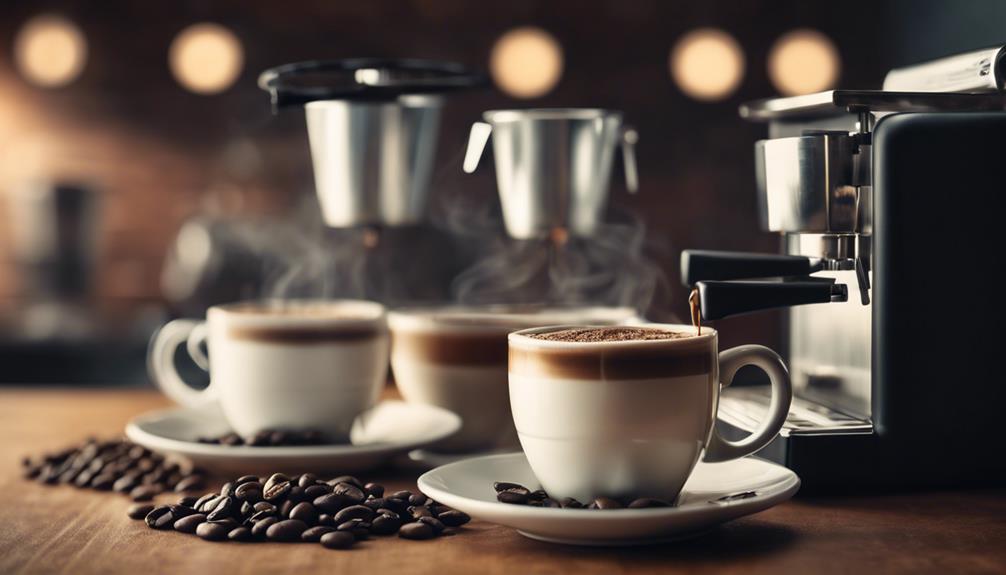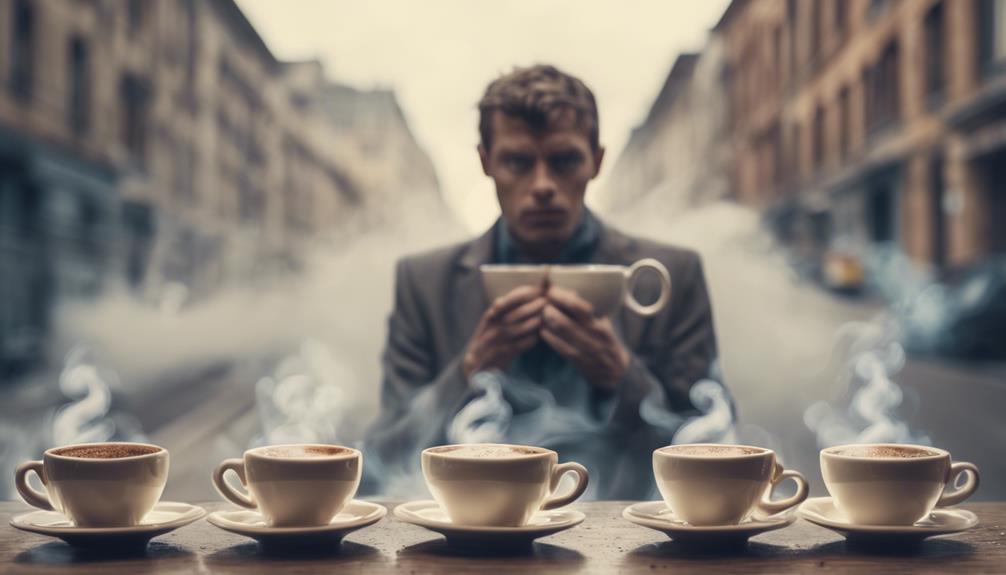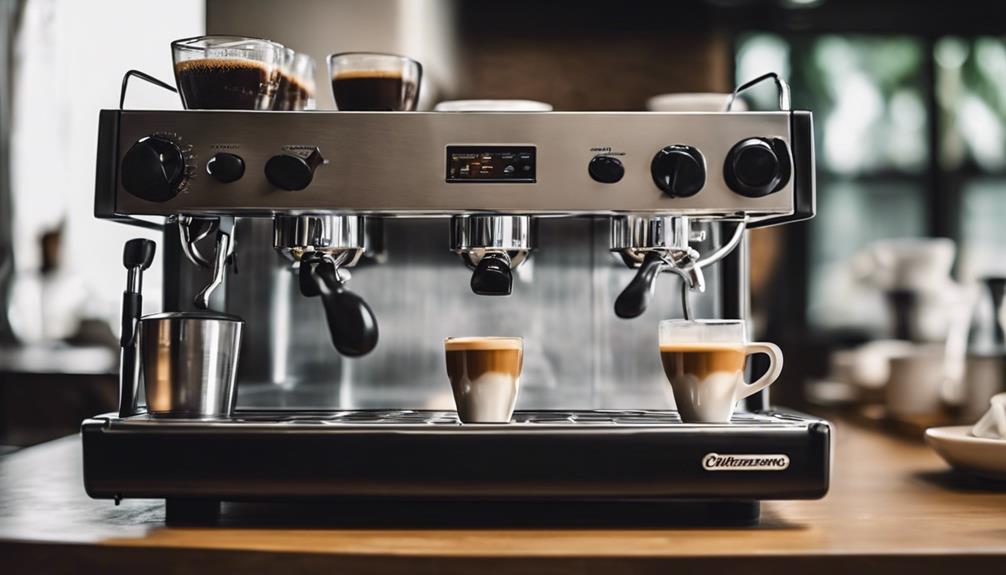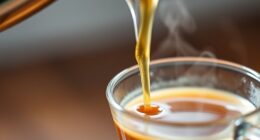You’re probably familiar with the bold, rich flavor of espresso, but its lesser-known relative, lungo, offers a unique twist on the classic shot. Lungo is essentially a longer version of espresso, with a larger volume and a more balanced flavor profile. While espresso typically measures about 30ml with a 1:2 coffee-to-water ratio, lungo measures around 60ml with a 1:3 or 1:4 ratio. This difference in brewing method and ratio results in a smoother finish with a touch of bitterness, subtle sweetness, and complexity. As you delve into the world of lungo, you’ll find even more nuances to enjoy.
Key Takeaways
- Lungo is an espresso variation with a longer extraction time, resulting in a larger volume (60ml) and a milder flavor profile.
- Espresso has a richer, bolder flavor with a thicker crema, while lungo has a smoother finish and a balanced taste due to its longer extraction time.
- The coffee-to-water ratio differs between the two, with espresso using 1:2 and lungo using 1:3 or 1:4, affecting the flavor and caffeine content.
- Lungo has a slightly higher caffeine content (70-80mg) than espresso (63mg) due to its longer extraction time, despite having a lower caffeine concentration per ounce.
Understanding the Basics
When you explore the world of coffee, you'll often come across two popular options: lungo and espresso, but what sets them apart is their distinct brewing processes and flavor profiles.
As you dive deeper into these coffee drinks, you'll notice that lungo is an espresso variation that translates to 'long' in Italian. This name indicates a longer extraction time and larger volume compared to standard espresso.
In fact, a standard espresso measures about 30ml (1 ounce), while a lungo typically measures approximately 60ml (2 ounces). You'll also find that the coffee-to-water ratio for espresso is 1:2, whereas lungo uses a ratio of 1:3 or 1:4.
Both drinks utilize the same amount of coffee, typically around 14g. However, the differences in water volume and extraction time lead to distinct flavor and caffeine content variations.
Understanding these basic differences will help you appreciate the unique characteristics of each drink and make informed choices when ordering your next cup of coffee.
Espresso Vs Lungo Characteristics
As you explore the distinct brewing processes of lungo and espresso, you'll notice significant differences in their characteristics, from size and volume to flavor profile.
One of the most noticeable differences is in size and volume. A standard espresso shot is approximately 30 ml, while a lungo shot typically measures around 60 ml, effectively doubling the volume of coffee extracted. This difference in volume affects the brew ratio, with espresso having a ratio of 1:2 and lungo utilizing a ratio of 1:4, resulting in more water relative to coffee grounds.
The extraction time also varies, with espresso brewed in about 20-30 seconds and lungo requiring a longer extraction time of approximately 30-40 seconds. Additionally, the grind size differs, with espresso requiring a finer grind for quick extraction under high pressure, and lungo needing a slightly coarser grind to prevent over-extraction and bitterness.
These differences in characteristics ultimately impact the flavor profile, with espresso delivering a rich and bold flavor and lungo offering a milder and more balanced taste.
Lungo Coffee Flavor Profile

As you explore the world of lungo coffee, you'll notice that its flavor profile is characterized by a balanced and mild taste.
This is due to the longer extraction time and increased water volume used in brewing, which results in a smoother finish.
You'll find that the flavor nuances of lungo are more influenced by the brewing method and water volume than by the type of coffee beans used.
Taste Profile Characteristics
You'll notice that lungo coffee boasts a more balanced and milder taste profile compared to espresso, primarily due to its longer extraction time and higher water content. This difference in extraction time considerably affects the flavor you experience.
With a brew ratio of 1:4, lungo's larger volume and softer flavor allow you to appreciate the nuances of the coffee bean. In contrast, espresso's 1:2 ratio yields a bolder, more intense flavor.
As you sip your lungo, you might detect a hint of bitterness due to the extended extraction process, which pulls more oils and flavors from the coffee grounds. However, this bitterness is balanced by the subtle sweetness and complexity of the coffee.
The flavor profile of lungo is often more layered and refined, revealing the unique characteristics of the coffee bean. By understanding the differences in extraction time and brew ratios, you'll appreciate the distinct taste experiences that lungo and espresso offer.
Balanced and Mild Flavor
Lungo's balanced and mild flavor profile is a direct result of its unique brew ratio and longer extraction time, which yields a coffee that's both refined and nuanced.
When you sip a lungo, you'll notice a harmonious blend of roasty and mild flavors that make it a popular choice for those seeking a lighter alternative to traditional espresso.
Here's what you can expect from lungo's balanced flavor:
- A milder taste compared to espresso, thanks to a brew ratio of 1:4
- A more balanced flavor profile due to the longer extraction time of approximately 30-40 seconds
- A softer and less intense flavor experience that's gentler on the palate
- A hint of bitterness that adds complexity to the flavor without being overpowering
Ristretto: The Short and Sweet
As you explore the world of ristretto, you'll notice it's brewed differently than your average espresso.
You'll get a richer flavor profile thanks to the shorter extraction time, which brings out the best in your coffee beans.
Ristretto Brewing Method
By using the same amount of coffee as espresso but with less water, ristretto brewing creates a concentrated shot that's both rich and sweet. This method allows you to experience the intense flavors of your coffee in a unique way.
Here's what you need to know about the ristretto brewing method:
- You'll use the same amount of coffee as you'd for an espresso, but with about half the water.
- The shorter extraction time, typically around 15-20 seconds, brings out the coffee's natural sweetness and concentrates its flavors.
- A finer grind is often used for ristretto, which helps to release more of the coffee's natural oils and flavors.
- With less water, the flavors are more intense, and the resulting shot is less bitter than a regular espresso.
Richer Flavor Profile
With its unique brewing method, you're able to savor a richer flavor profile in ristretto, where the shortened extraction time and precise brew ratio combine to intensify the coffee's natural flavors and aromas.
By using the same amount of coffee as espresso but with less water, you get a more concentrated brew that's packed with flavor. The result is a sweet, fruity, and fragrant coffee experience that's less bitter than standard espresso.
The 1:1 brew ratio in ristretto contributes to its richness, allowing the coffee's nuances to shine through. You'll notice a more balanced flavor with notes of fruit and subtle sweetness, making it a favorite among coffee connoisseurs.
The reduced amount of water used in ristretto brewing guarantees that the coffee's natural oils and flavors are preserved, giving you a more authentic taste experience.
Shorter Extraction Time
You'll experience a shorter extraction time with ristretto, which yields a more concentrated brew that's packed with flavor. This is because ristretto is brewed using the same amount of coffee as espresso, but with less water, resulting in a shot size of 15-20 ml. The extraction time for ristretto is considerably shorter, typically around 15-20 seconds, which allows for a more precise capture of the coffee's sweeter and more fragrant notes.
Here are some key benefits of ristretto's shorter extraction time:
- Less water used in the brewing process
- More concentrated brew with a 1:1 brew ratio
- Sweeter and more fragrant flavor profile with less bitterness
- Unique preparation method that brings out fruity and fragrant notes
Brewing Techniques Compared

Compare the brewing techniques of lungo and espresso, and you'll notice distinct differences in pressure, coffee grind, water temperature, and extraction time that set these two coffee drinks apart.
When using an espresso machine, you'll need to adjust your brewing techniques to achieve ideal flavor in each preparation. For espresso, you'll apply high pressure (9 bar) to finely-ground coffee (7-10 grams) with an extraction time of 20-30 seconds.
In contrast, lungo uses the same amount of coffee but with more water and a longer extraction time of 30-40 seconds. You'll also need to adjust the water temperature, with espresso typically brewing at 190-205°F and lungo requiring slightly cooler water to prevent over-extraction.
The grind size is also important, with a fine grind for espresso and a slightly coarser grind for lungo to achieve a balanced flavor profile during the extended extraction.
Mastering these brewing techniques, including tamping pressure and water flow, is essential for bringing out the unique characteristics of each drink.
Coffee-to-Water Ratios Explained
Now that you've mastered the brewing techniques, it's time to explore the role of coffee-to-water ratios in shaping the flavor profiles of lungo and espresso. The coffee-to-water ratio is a critical factor in determining the strength, flavor, and bitterness of your coffee.
For espresso, the typical ratio is 1:2, using 15 grams of coffee for 30 ml of water, resulting in a concentrated shot. In contrast, lungo has a ratio of approximately 1:3 or 1:4, using the same amount of coffee but with 60 ml of water for a milder flavor.
Here are some key takeaways to keep in mind:
- The coffee-to-water ratio directly affects the flavor profile and bitterness level of your espresso coffee.
- A higher water content in lungo leads to a longer extraction time, which can impact the flavor.
- Proper coffee-to-water ratios are essential for ideal extraction and achieving desired flavor profiles.
- Understanding these ratios helps you adjust your brewing methods to suit your personal taste preferences.
Caffeine Content Differences

When you're deciding between a lungo and an espresso, you'll want to take into account the caffeine kick.
You'll find that lungos typically pack a slightly higher caffeine punch than espressos, thanks to the longer extraction process.
Now, let's break down the numbers and explore how these caffeine levels compare.
Caffeine Levels Compared
You'll find a notable difference in caffeine content between lungo and espresso, with the former boasting a slightly higher amount due to its longer brewing time and increased water volume. This means that if you're looking for a stronger caffeine kick, lungo might be the better choice. But what exactly are the numbers?
Here's a breakdown of the caffeine levels in each drink:
- A standard espresso shot (30ml) contains approximately 63 mg of caffeine.
- A lungo (60ml) can contain around 77 mg of caffeine on average.
- The difference in caffeine content between the two beverages is minimal but noticeable, with lungo having around 14 mg more caffeine than espresso.
- Despite the additional caffeine in lungo, the flavor profile can make it feel less intense compared to the concentrated taste of espresso.
Keep in mind that these are just general guidelines, and caffeine levels can vary depending on the specific coffee beans and brewing methods used.
However, if you're sensitive to caffeine or looking to manage your intake, it's worth considering the differences between lungo and espresso.
Lungo's Slightly Higher Caffeine
As you weigh your caffeine needs, it's clear that lungo's slightly higher caffeine content, courtesy of its longer extraction process, makes it a better fit for those seeking an extra boost.
With a typical lungo containing around 70-80 mg of caffeine compared to espresso's 63 mg, the difference may not be dramatic, but it's definitely noticeable. This increase in caffeine is largely due to the additional water used in lungo, which enhances caffeine extraction.
Since you're getting more caffeine in a lungo, you might assume it's the better choice for caffeine lovers. However, it's crucial to reflect on the concentration of caffeine per ounce.
Despite having more caffeine overall, lungo's larger volume means the concentration of caffeine is actually lower compared to espresso. So, if you're looking for a stronger, more intense caffeine kick, espresso might still be the way to go.
Understanding these caffeine content differences empowers you to make informed decisions based on your unique caffeine preferences and tolerance.
Espresso's Caffeine Concentration
Frequently, espresso's concentrated caffeine kick is what sets it apart from lungo, with a whopping 63 mg of caffeine packed into a mere 30 ml shot. This intense caffeine concentration is due to the unique brewing process, where high-pressure hot water is used to extract the coffee grounds. As a result, you get a strong, rich flavor and a boost of energy in a small package.
Here are some key points to keep in mind about espresso's caffeine concentration:
- Espresso typically contains 63 mg of caffeine per 30 ml shot.
- This concentrated dose is due to the high-pressure brewing process.
- Despite using the same amount of coffee grounds as lungo, espresso's water volume is considerably lower.
- This lower water volume contributes to a higher caffeine concentration.
Debunking Common Misconceptions
When it comes to lungo and espresso, misconceptions abound, and it's time to set the record straight. You might've heard that lungo is just a diluted espresso, but that's far from the truth. In reality, lungo is brewed with more water and a longer extraction time, resulting in a distinct flavor profile and strength.
You're not alone if you've confused lungo with caffè americano or long black. However, an americano is made by adding hot water to a shot of espresso, whereas lungo is brewed with more water from the start. Similarly, a long black is made by adding espresso to hot water, whereas lungo is brewed longer with more water.
Another common misconception is that lungo contains considerably less caffeine than espresso. In reality, lungo can have slightly more caffeine due to its longer extraction time, despite being milder in flavor.
While casual coffee drinkers mightn't notice the differences between lungo and espresso, enthusiasts will appreciate the unique brewing processes and resulting flavor distinctions. By understanding the differences between lungo and espresso, you'll be able to appreciate the nuances of each brewing method and enjoy your coffee to the fullest.
Variations of Lungo Coffee

Now that you're well-versed in the differences between lungo and espresso, it's time to explore the exciting variations of lungo coffee that can elevate your coffee experience. You might be thinking that lungo is just a one-trick pony, but think again! This coffee drink has a world of possibilities waiting to be discovered.
Here are some variations of lungo coffee you can try:
- Iced Lungo: Serve your lungo over ice for a revitalizing coffee drink perfect for warm weather.
- Lungo con Leche: Add milk to your lungo to soften its natural bitterness and create a creamy coffee treat.
- Black Lungo: Enjoy your lungo in its purest form, without any additives, to appreciate its unique flavor profile.
- Flavored Lungo: Add flavored syrups or spices to give your lungo a personal touch and enhance your coffee experience.
The Perfect Cup: Experimentation
By tweaking a few key variables, you can access the full potential of your lungo and espresso brews, transforming an ordinary cup into an extraordinary experience.
When experimenting with your brews, start by adjusting the grind size. A slightly coarser grind can enhance the flavor of your lungo, while a finer grind is ideal for espresso to achieve ideal extraction.
Next, play with the brewing time – lungo typically requires a longer extraction of about 1 minute, while espresso is best brewed for 20-30 seconds.
Don't forget to test different coffee-to-water ratios, as this can greatly impact the strength and flavor of your brew. For lungo, a ratio of 1:4 is standard, while espresso maintains a ratio of 1:2.
You can also try various coffee bean types to diversify flavor profiles. Different beans will interact uniquely with the brewing methods of both lungo and espresso, enhancing the overall coffee experience.
Frequently Asked Questions
Is a Lungo Stronger Than Espresso?
You might think a lungo is stronger than espresso due to its higher caffeine content, but its milder flavor and potential bitterness might make you perceive espresso as more intense, depending on your taste.
Do I Use Espresso or Lungo for Latte?
As you navigate the rich landscape of coffee, you ponder: do I use espresso or lungo for latte? Consider your taste buds' desire: do you crave a bold, intense flavor or a smoother, more velvety ride?
What Does Lungo Mean in Nespresso Pods?
When you see "lungo" on a Nespresso pod, it means you're getting a longer shot of coffee, around 110ml, with a milder flavor profile, optimized for a 60-70 second brewing time, perfect for sipping on its own or using in milky drinks.
Can You Add Milk to Lungo Coffee?
You can definitely add milk to your lungo coffee, which is often called "lungo con leche" – it softens the bitter taste, creates a creamy texture, and enhances the flavor profile, making it more accessible to your taste buds.
Conclusion
You've navigated the nuances of lungo vs espresso, and now you're equipped to tackle the world of coffee connoisseurs. Next, you can impress the most discerning coffee aficionados by experimenting with unique coffee combinations and creations. For example, try infusing your espresso with a hint of vermouth and a splash of vodka to create a delicious martini espresso. This unexpected twist on a classic beverage is sure to elevate your status in the world of coffee connoisseurs.
Remember, lungo's smooth, velvety texture is a far cry from espresso's bold, rich punch. But amidst their differences, both share a common goal: to deliver a perfect cup that awakens your senses.
So, go ahead, experiment, and find your ideal balance. The world of coffee is full of endless possibilities, and it's time for you to write your own brewing story.









